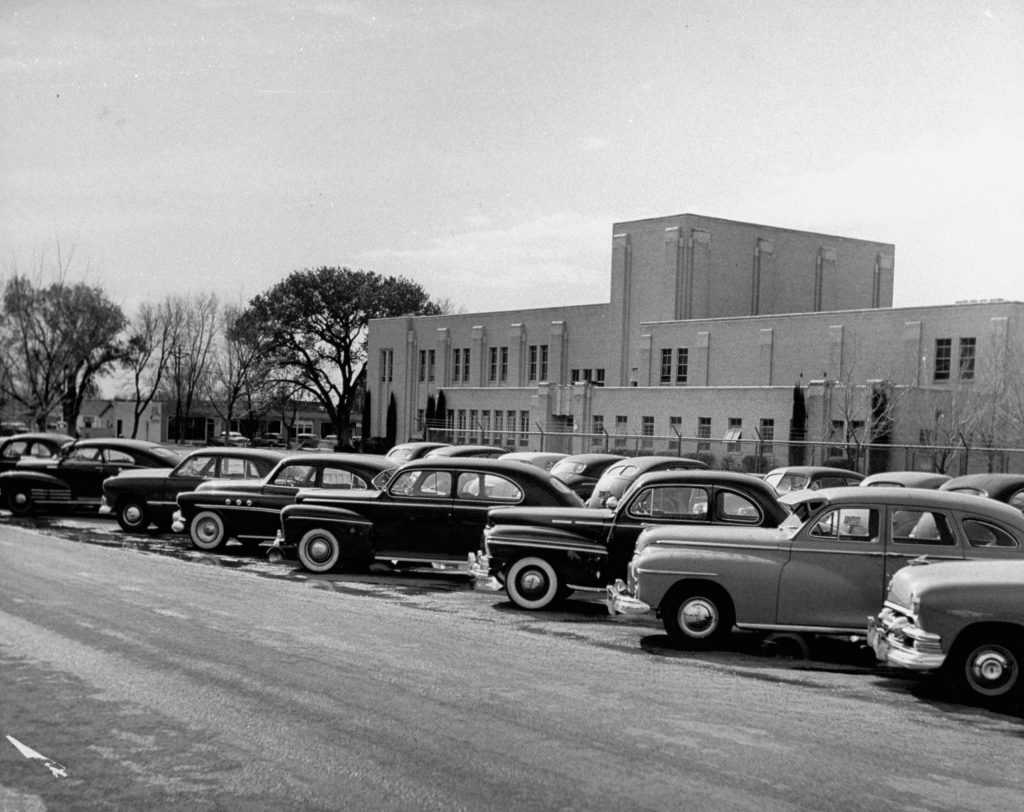Written By: Ben Cosgrove
If there’s one thing humans like to do, it’s label ourselves and one another. Sometimes those labels, applied to vast numbers of people, are obviously laudatory (The Greatest Generation). Sometimes they’re pitying (The Lost Generation). Sometimes they’re duly withering (The Me Generation). And sometimes, at least in the moment, they’re just plain accurate.
In June 1954, LIFE magazine published an article titled “The Luckiest Generation” that, revisited decades later, feels like an almost perfect snapshot of a certain segment of American society at a particular moment in the nation’s history. We’ll let LIFE set the scene:
The morning traffic and parking problems became so critical at the Carlsbad, N.M., high school that school authorities in 1953 were finally forced to a solution: they set aside a special parking area for students only. In Carlsbad, as everywhere else, teenagers are not only driving new cars to school but in many cases are buying them out of their own earnings. These are the children who at birth were called “Depression babies.” They have grown up to become, materially at least, America’s luckiest generation.
Young people 16 to 20 are the beneficiaries of the very economic collapse that brought chaos almost a generation ago. The Depression tumbled the nation’s birth rate to an all-time low in 1933, and today’s teenage group is proportionately a smaller part of the total population than in more than 70 years. Since there are fewer of them, each in the most prosperous time in U.S. history gets a bigger piece of the nation’s economic pie than any previous generation ever got. This means they can almost have their pick of the jobs that are around. . . . To them working has a double attraction: the pay is good and, since their parents are earning more too, they are often able to keep the money for themselves.
A few things to point out here. First, and most disheartening, is the racial makeup of the “teenage group” that LIFE focused on, at least pictorially, in that 1954 article: there are no people of color.
Second, the nature of the boon of the improbable and unprecedented good fortune that befell these kids is not that they’re spoiled rotten, or that every possible creature comfort has been handed to them. Instead, it’s that they have the opportunity to work at virtually any job they choose. “They are often able to keep the money” that they earn.
So, yes, they were lucky and compared to countless generations of youth who came before, all over the world, white working- and middle-class teens in 1950s America were, for the most part, incredibly lucky. But unlike the entitled creatures that most of us would count as the “luckiest” (and the most obnoxious) among us these days, the teens profiled in LIFE in 1954 don’t look or feel especially coddled.
They look secure. They look confident. They look, in some elemental way, independent. They’re learning, day by day, what it means to make one’s way in the world.
In that sense, maybe they were the luckiest generation, after all.
Liz Ronk edited this gallery for LIFE.com Follow her on Twitter at @LizabethRonk.

In an aura of fun and well-being, students danced at weekly Sock Hops in a Carlsbad high school gyn. The music was provided by a 12-piece student band.
Nina Leen The LIFE Picture Collection/Shutterstock

Cars of Carlsbad High students in their parking lot.
Nina Leen The LIFE Picture Collection/Shutterstock

An electrician, Jack Harris, 16, still in school, picked up good pay doing part-time repair jobs.
Nina Leen The LIFE Picture Collection/Shutterstock

A young sales girl holding up a blouse to a store customer.
Nina Leen The LIFE Picture Collection/Shutterstock

A young investor, David Lenske, 17, having bought four shares of A.T.&T., talked with a banker.
Nina Leen The LIFE Picture Collection/Shutterstock

The Luckiest Generation: 1950s Teenagers
Nina Leen The LIFE Picture Collection/Shutterstock

The Luckiest Generation
Nina Leen The LIFE Picture Collection/Shutterstock

The prosperous pay-off of after-school jobs brought Mike Sweeney and Harold Riley (right) with Pat Marsh (left) and Nita Wheeler, all 17, to Carlsbad’s Red Barn restaurant, a favorite party spot.
Nina Leen The LIFE Picture Collection/Shutterstock

Young couples at a formal dance dreamily swaying on the crowded floor of a ballroom lit by a chandelier.
Nina Leen The LIFE Picture Collection/Shutterstock

The Luckiest Generation
Nina Leen The LIFE Picture Collection/Shutterstock

The Luckiest Generation
Nina Leen The LIFE Picture Collection/Shutterstock

The Luckiest Generation
Nina Leen The LIFE Picture Collection/Shutterstock

Pay in trade was taken by Margaret High, 17, who worked in a music store and spent her salary on records.
Nina Leen The LIFE Picture Collection/Shutterstock

Rada Alexander, 19, a bookkeeper, earned $200 a month in a job she got with an auto firm after graduation.
Nina Leen The LIFE Picture Collection/Shutterstock

Jere Reid Jr., 17, who bred chinchillas, held one valued at $3,000.
Nina Leen The LIFE Picture Collection/Shutterstock

Sonny Thayer, 19, packed for a hunting trip.
Nina Leen The LIFE Picture Collection/Shutterstock
























